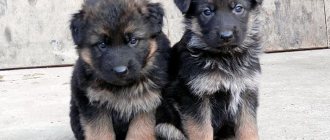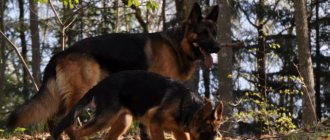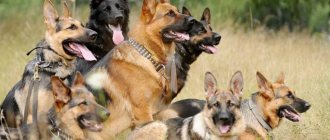- home
- Dogs
- How to choose and raise German Shepherd puppies
German Shepherd puppies have a number of differences from all other breeds, both in appearance and in character and intelligence. When starting a conversation about German Shepherd puppies, you should understand that we are talking about a unique creature, ideal for living next to a person. The German Shepherd is as similar in appearance as a wild, timber wolf: the same strength, grace, fearlessness and the ability to live in the most unfavorable conditions. But unlike the wolf, the dog’s psyche is built on serving the owner. There is no more hard-working breed than the German Shepherd; pleasing its owner with its work is the goal of its life. Hearing approval from the lips of a loved one is better for a shepherd than any treat. When choosing a pet, fixing his gaze on a German shepherd, a person must understand: there will be no more loyal creature in his life, and he must respond to this with love and care.
German Shepherd puppies have a number of differences from all other breeds both in appearance and in character and intelligence
Appearance of a German Shepherd puppy
In order not to make a mistake with your choice and not accidentally take a large mongrel into your home, you need to know what German Shepherd puppies look like. A week-old animal is not much different from puppies of other large breeds. This continues for about the first 3 weeks, then generic differences begin to appear in appearance. German Shepherd puppies, 3 weeks old, already differ from other breeds with their eyes. At that age, they are already very expressive, smart, and lively. A mongrel's eyes are more convex and rounded; a shepherd's eyes are almond-shaped and dark brown, but up to 2 months they can be blue. When an animal turns its head, looking at surrounding objects, the clear white of the eye is visible, which makes them look like humans.
Choosing the gender of the dog
An important point is the choice of the gender of the future dog. In order to decide, you need to understand for yourself what you can cope better with - everyday difficulties or psychological ones.
When buying a male, psychological difficulties will arise. Males always show more aggression than females and try to take a leading position in the house. In addition, males need more attention during training (training), and also become disobedient when approaching a female in heat. The advantages of males are their large size and massiveness. They can breed more often than females. Male owners do not have the hassle of caring for puppies.
When buying a girl, the difficulties will be more domestic. They periodically go into heat, which can cause an unplanned pregnancy if you do not keep an eye on the dog. The owner of the female bears all the problems of giving birth and raising puppies. The advantages of bitches are their flexibility and affection for their owner, which makes them easier and faster to train.
Gallery: German Shepherd puppies (25 photos)
How to choose a puppy?
So, the future owner has decided what a German Shepherd puppy looks like, now he needs to choose a friend. Yes, a German Shepherd will not just be a dog guarding a house or yard, it will be a friend with whom the owner will learn to talk and understand each other. When choosing a dog, you must remember: due to the fact that a dog’s life is relatively short, on average 15-18 years, for its owner it will be only a page in life, but for its owner it will become its whole life.
Choosing a male or female is a purely personal matter, but the age is quite certain. The owner must pick up the dog no later than when it turns 3 months old. As the puppy gets older, it begins to grow and develop intellectually more intensively, and not every breeder can give the dog as much attention as it needs. It is at this moment in the puppy’s life that his human friend should appear.
So, the selected puppy should not have white spots on its coat or too light tan marks. The backbone should be strong, the tail like a saber, confident movements. The puppy should be inquisitive and playful, this indicates his health. And the more curious the animal, the smarter it is.
Monthly development
There are a number of skills that a puppy should be able to do if raised correctly. The list below is not an exact guide, but rather recommendations.
From 2 to 3
Approaching the owner and landing, the command “Place”, playing ball. You need to learn the basics of fetching, searching for objects , and also accustom your dog to a leash.
From 3 to 4
Command “Come to me”: The puppy comes up and sits at the owner’s left leg, walking around him from behind. Leash: Doesn't pull or lag, can turn. The shepherd dog searches for objects and performs fetching at a distance of no more than three meters; they begin to teach it the basics of tracking the scent.
Games involving tugging a stick or rag stop until the molars grow.
From 5 to 6
The learned commands are executed correctly, and the dog also knows “Near”, “Fu”, “No” , the object of the fetch is given on command. If the owner stops walking, the shepherd sits down and does not show interest in strangers.
Command “Lie down”: the puppy remains in a lying position for several seconds.
From 6 to 7
Independently takes a place at the left leg, the thrown object is given to the owner. They begin to accustom them to the “Near” command without a leash; good grip develops.
From 7 to 8
Cultivating endurance. The dog is taught to use gesture commands at a distance . Learned commands are reinforced by their constant repetition. The first attempts to crawl begin. They teach you to take hurdles no higher than 50 cm and walk on a boom.
From 8 to 10
Learned skills are reinforced. Shepherd dog learns to walk on open stairs.
More than 10 months
Refinement of techniques with the help of a professional trainer and repetition of everything learned. The German Shepherd is unpretentious and hardy, easy to train , but requires time and attention. Without making mistakes in raising a dog, its owner can raise a good and loyal friend.
Daily routine and feeding of the puppy
A German Shepherd puppy is easy to train. In order for him to grow healthy and strong, he must walk and eat at the same time. The walking time increases every month. Ideally, a German Shepherd should spend 3 to 5 hours a day outside. During the day, you should choose a time for classes. The animal must work, even if it lives in an apartment and is an ordinary civilian dog. To work means to carry out commands.
Walks should be started only after vaccination has been carried out according to all the rules: after 1 vaccination, 10 days pass, then repeated vaccination is done, and again 10 days of quarantine. All this time the puppy should be at home, since during this period he is most susceptible to diseases.
Don't forget to give your dog deworming medications. Parasites from wool should be removed regularly using special means. In the future, it is best not to wait for them to appear, but to put on a permanent anti-parasitic collar for the dog or treat the fur with special means as a preventive measure. Ears should also be cleaned regularly.
A shepherd puppy should be fed according to the following schedule (per day):
- up to 2 months - 6 times;
- up to 4 months - 4 times;
- up to 6 months - 3 times;
- after 6 months - 2 times.
It is important to monitor the calcium content of your animal's food. A distinctive feature of German Shepherd puppies is their rapid growth from 3 months to 6 months. At this time, they gain the height and weight of an almost adult dog. If a male dog should be 65 cm at the withers, then a puppy gains 55 cm in six months. Such rapid growth is impossible without proper nutrition and supplying the body with calcium. Therefore, dogs at this age often have dysplasia - weak joints. And with a lot of weight, this causes severe pain to the puppy, he stops walking. The disease is treated by intensively feeding the body with necessary substances.
The German Shepherd's diet includes head meat, offal, and poultry. You can give fish, but only without bones and boiled. The dog willingly eats various porridges: rice, millet, oatmeal or buckwheat. You can diversify the menu with crackers. Another distinctive feature of the German Shepherd is its unpretentiousness in food. A dog can eat the same dish for years without getting tired of it. You just need to please him sometimes with biscuits and fresh fruit.
In the modern world, especially in big cities, it is customary to feed your dog dry food. An experienced veterinarian will help you understand the huge variety of products offered. He will also suggest a dry food feeding plan.
To prevent your puppy from suffering from constipation and diarrhea, baked goods, legumes, pasta, smoked meat and fish must be excluded from his diet. After eating, especially if he eats dry food, you need to give him fresh water to drink.
Food should not be hot or too cold; it should be served in a special bowl in a permanent place. From childhood, a puppy must be taught to eat only in its place and only from the hands of its owner. We need to teach him not to pick up food from the floor. Someday this science will save his life, because it is known that rat poison disguised as food can be scattered along the city streets.
How to educate correctly?
Puppy
From the early days of life, a puppy must learn acceptable standards of behavior . Training is carried out in the form of educational games and tasks; the dog must be rewarded with treats. You should be patient: due to age, not everything will work out right away.
In case of failure, it is unacceptable to scream and hit the animal - the puppies have not yet fully strengthened their psyche.
Relationships with your pet should be built on mutual trust and love.
Adult dog
If it so happens that the shepherd was not trained in childhood, it is quite possible to train it at an older age , but it will not be as easy as with a puppy. One of the main tasks will be establishing contact.
The basic principles of training remain the same. If an omission in the training process is the fault of the dog owner, it is necessary to exert a more severe influence on the animal. Hitting, humiliating and shouting at a dog is still prohibited.
However, if the shepherd dog was adopted as an adult, then the first thing you need to do is give it time to get used to its new owner and conditions. The training process will be long. Any results should be expected only after the dog begins to trust the new owner. They start with basic commands and without the presence of outsiders.
At home
You can train a German Shepherd at home on your own . First of all, she is taught discipline. It is not recommended to allow your puppy something just because he is still small. The dog should have certain places to rest and eat.
Training with a dog handler
If for some reason the owner of the dog cannot train the dog on his own, or if the adult shepherd dog has developed negative habits, he has to turn to dog handlers for help.
Specialists can both teach the animal basic commands and correct its behavior. The principles of training remain the same, but the methods may vary depending on the dog's individual personality traits .
Behavior correction
Some shepherds, if not raised correctly, can become aggressive and also acquire many other negative qualities. In this case, you have to resort to behavior correction, often with the help of dog handlers.
Main reasons:
- the dog shows aggression towards the owner and other animals;
- refuses to follow commands;
- runs away without a leash;
- afraid of people, animals, cars;
- cannot learn to use the toilet outside.
All this is due to the fact that the owner made mistakes in upbringing and was unable to accustom the shepherd to the conditions of the outside world. The older the animal, the more difficult and longer the correction lasts .
Sometimes the cause may be congenital mental abnormalities. In this case, the dog's abnormal behavior can be corrected, but there is a possibility that after some time it will return to its original state.
Safety precautions
If a shepherd puppy grows up in a city apartment, a number of rules must be followed to protect it from injury. There are almost no differences here from other puppies or even small children:
- Wires should be hidden in special boxes or plinths.
- Strengthen or remove unstable furniture.
- Don't let him play with small, fragile toys: he will definitely break them and swallow the fragments.
- Anything that lies within his reach will be stolen and turned into a toy, so things must be put away in cabinets and drawers.
- To prevent the puppy from sharpening its teeth on all surrounding objects, it must have its own training equipment. They are sold in abundance in veterinary pharmacies - these are bones from ox veins, and scraps of rope, and cast heavy balls. You need to bring home 2-3 toys, and he will choose his favorite one.
- There should be a carpet or other similar covering on a slippery floor: the puppy’s weak paws are easily injured on a slippery floor.
- If there are children in the house, they need to be instructed how to properly handle the dog. The main thing is not to allow him to be picked up: even at three months he is quite heavy, up to 10 kg, and his paws are weak, they can easily be injured if he is accidentally dropped.
Required vaccinations
Speaking of puppy safety, you should also know about vaccinations. Yes, German Shepherds are practically wolves, but we should not forget that they were bred by humans, and they are susceptible to many diseases, most of which are fatal. In order for your dog to develop immunity against major diseases, it should be vaccinated regularly.
1 vaccination is given at the age of 2 months. Before vaccination, deworming is carried out - treatment for worms. The 2nd vaccination is carried out at 7-8 months, then at 1 year and then annually. Before each vaccination, treatment for worms is carried out.
Dog breeders and veterinarians are still arguing about the need for rabies vaccination. The situation with this disease is not simple: in the city, for example, you may not find a rabid animal, but in the forest there are probably some. So if the owner lives near a forest, then the rabies vaccination should still be done. Regarding the city dog, options are possible, since the rabies vaccine affects the dog’s growth rate, it can be done after a year, when it has fully grown.
Training a German Shepherd after 6 months
Once the dog is 6 months old, you can begin to learn all the commands that were previously forbidden. “Aport”, “Face”, “Voice” and “Alien” can now be instilled in your tomboy. In addition, you should begin to teach your ward proper behavior in public places.
After a six-month period of life, the dog may begin to be afraid of any objects. In such a situation, you should approach the object and touch it. This way the pet will understand that it is not dangerous. Ideally, provide the baby with the opportunity to sniff this ill-fated object.
The final formation of the character of German Shepherds occurs at 4 years. Puppies become adults and consolidate all their skills and instincts. Here you will see all the results of the educational lessons conducted.
Walking mode
For full development, the puppy should walk outside more. Of course, only after all vaccinations. When he is small, he can be taken out 5-6 times a day for 15-20 minutes. He must get used to going outside to relieve himself, so it is necessary to walk him immediately after sleep, after eating, and before bed. The older he gets, the longer the walks should be. The walk should be combined with games and training. After a year, the German Shepherd can be given for special training - capture, training in the “face” command. This is not necessary in order to turn him into a bodyguard; the shepherd will already protect his owner in a critical situation. This is necessary so that she gets used to discipline and unquestioning submission. After all, a large dog that cannot be controlled is a very dangerous phenomenon.
Walks should ultimately be at least 1 hour in the morning and 2 hours in the evening. In order for the dog to be socially active and not afraid of city noises, you should take it on short trips, guests, and give the puppy the opportunity to run around with peers.
Training a puppy begins from 1 month of his life: the earlier he starts to exercise, the more flexible his brain will become and the deeper his intellect. The first command for a puppy is his name. Then he can be taught commands: place, fu, sit, lie down, voice, next to him. These and several other similar commands make it easier to control the puppy and are called a general training course (GTC). He can take a special training course at a canine club or training school after a year.
Due to the ideal balance of strength and intelligence, the German Shepherd has become an indispensable assistant and partner for a person in almost all areas of his activity. She can be an excellent shepherd or guard. Millions of dogs of this breed serve in the military, police and other law enforcement agencies. They are sappers, trackers, and customs officers.
Choosing a dog class
Absolutely all dogs of any breed are divided into 3 classes:
- - show;
- - breed;
- — pet.
The class of puppies up to 5-9 months of age is determined approximately, since there is the possibility of moving to another group.
The show class is the most expensive . This includes absolutely healthy dogs with appearance strictly according to the standard. They are suitable for exhibitions where they are likely to win prizes and for breeding work.
The next most expensive is the brid class . This includes healthy dogs that are simply not as impressive in appearance as show class dogs. However, they are also suitable for breeding work.
The last class is pet . This includes animals that have serious deviations from the standard in appearance or disqualifying defects. Such dogs are not allowed for breeding. However, they will please their owner just as much or even better.
Show class German Shepherds are further divided into 2 subgroups - for show and for service. All of them can take part in exhibitions, but evaluate them according to different criteria.
If you are purchasing a dog to pose with you in photographs and videos, choose a puppy from a subclass show. If you need a dog to protect your home, territory and family, choose a puppy from working parents.











